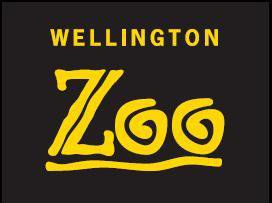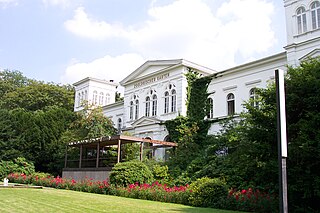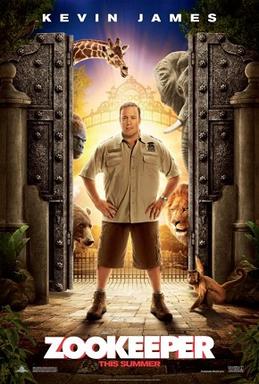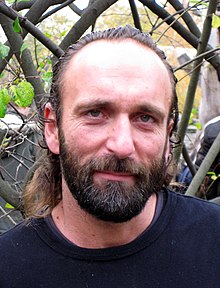
A zookeeper, sometimes referred as animal keeper, is a person who manages zoo animals that are kept in captivity for conservation or to be displayed to the public. They are usually responsible for the feeding and daily care of the animals. As part of their routine, the zookeepers may clean the exhibits and report health problems. They may also be involved in scientific research or public education, such as conducting tours and answering questions.

The Berlin Zoological Garden is the oldest surviving and best-known zoo in Germany. Opened in 1844, it covers 35 hectares and is located in Berlin's Tiergarten. With about 1,380 different species and over 20,200 animals, the zoo presents one of the most comprehensive collections of species in the world.

The San Francisco Zoo is a 100-acre (40 ha) zoo located in the southwestern corner of San Francisco, California, between Lake Merced and the Pacific Ocean along the Great Highway. The SF Zoo is a public institution, managed by the non-profit San Francisco Zoological Society, a 501(c)(3) organization. under a public-private partnership since 1993, receives $4.2 million annually from the city. As of 2016, the zoo housed more than one thousand individual animals, representing more than 250 species. It is noted as the birthplace of Koko the gorilla, and, from 1974 to 2016, the home of Elly, the oldest black rhinoceros in North America.

Binky was a polar bear who lived at the Alaska Zoo in Anchorage. He was originally orphaned near Cape Beaufort, close to the Chukchi Sea in the Alaska North Slope, and was found in Northwest Alaska by David Bergsrud. Alaska Fish and Game was contacted shortly after Binky's discovery, and arrangements were made to find a zoo in the Contiguous United States. Anchorage had a small zoo at the time, with an elephant that local grocer Jack Snyder had won in a contest and a few other donated animals.

The Aktiengesellschaft Cologne Zoological Garden is the zoo of Cologne, Germany. Being the third oldest zoo in Germany, it features over 10,000 animals of more than 850 species on more than 20 hectares. The internationally renowned zoo with an attached aquarium and invertebrate exhibit is active in preservational breeding of animals that are in danger of becoming extinct. In addition, in-the-wild conservation efforts and research focussing on animals of Madagascar, Wallacea, and Vietnam are actively promoted and supported via cooperation with Cologne University and local projects, such as in the case of Przewalski's horses.

Wellington Zoo is a 13-hectare (32-acre) zoo in the green belt of Wellington, New Zealand.

Wuppertal Zoo is a 24-hectare (59-acre) zoo in Wuppertal, Germany. About 5,000 animals from around the world live at the zoo, representing about 500 species, including apes, monkeys, bears, big cats, elephants, as well as birds, reptiles, and fish.

Inuka was a male polar bear and one of the mascots of the Singapore Zoo. Born and housed in a climate-controlled enclosure, he was the world's only "tropical polar bear".

The Tierpark Berlin is one of two zoos located in Berlin, Germany. It was founded in 1955 and is located in Friedrichsfelde on the former grounds of Friedrichsfelde Palace, which is situated within the zoo. As of 31 December 2013, the zoo houses 7,250 animals from 846 species, in an area of 160 hectares. Tierpark Berlin also features two public exhibits free of charge, one being the Bärenschaufenster for American black bears. The park is also home to the Treskow family's historic family burial ground.

Kolmården Wildlife Park is a zoo that opened in 1965 overlooking Bråviken bay in Sweden. It is the largest zoo in Scandinavia, includes the first dolphinarium in Scandinavia, which opened in 1969 and has daily shows, and the world's first cable car safari. The wildlife park also has a birds of prey display and a seal show. In the Marine World area is a roller coaster called "The Dolphin Express". Another, larger, roller coaster in the park is Wildfire.

Flocke is a female polar bear who was born in captivity at the Nuremberg Zoo in Nuremberg, Germany on 11 December 2007. A few weeks after her birth, she was removed from her mother's care after concerns were raised for her safety. Although the zoo had established a strict non-interference policy with its animals, officials chose to raise the cub by hand. This decision came at a time when the zoo was receiving negative attention from the media after another female polar bear reportedly ate her newly born cubs.

Wilbär is a polar bear who was born in captivity at the Wilhelma Zoo in Stuttgart, Germany on December 10, 2007. Wilbär made his first public appearance on April 16, 2008, swimming alongside his mother. His name comes from combining the name of the zoo with the German word for bear. Zoo officials have registered the name as a trademark.

Nuremberg Zoo is a zoo located in the Nuremberg Reichswald, southeast of Nuremberg, Germany. With an area of 67 hectares, approximately 300 animal species are kept by the zoo.

Knut was an orphaned polar bear born in captivity at the Berlin Zoological Garden. Rejected by his mother at birth, he was raised by zookeepers. He was the first polar bear cub to survive past infancy at the Berlin Zoo in more than 30 years. At one time the subject of international controversy, he became a tourist attraction and commercial success. After the German tabloid newspaper Bild ran a quote from an animal rights activist that decried keeping the cub in captivity, fans worldwide rallied in support of his being hand-raised by humans. Children protested outside the zoo, and e-mails and letters expressing sympathy for the cub's life were sent from around the world.

Zookeeper is a 2011 American fantasy comedy film directed by Frank Coraci, with a screenplay by Nick Bakay, Rock Reuben, Kevin James, Jay Scherick, and David Ronn, from a story by Scherick and Ronn, and produced by Todd Garner, James, Adam Sandler, Jack Giarraputo, and Walt Becker. The film stars James, Rosario Dawson, and Leslie Bibb with supporting roles by Ken Jeong, Donnie Wahlberg, Joe Rogan, Nat Faxon, and Tom Woodruff Jr., alongside the voices of Cher, Nick Nolte, Sandler, Sylvester Stallone, Judd Apatow, Jim Breuer, Jon Favreau, Faizon Love, Richie Minervini, Maya Rudolph, and Bas Rutten. It is about an unlucky zookeeper and the talking animals at his zoo who break their silence to help him find love.

Siku is a male polar bear. He has several siblings such as Sné. After his mother failed to produce enough milk to feed him, he was taken into care in the Scandinavian Wildlife Park in Denmark.

Polar Bear Shores is a polar bear exhibit at the Sea World theme park on the Gold Coast, Australia. As of 2023, the exhibit features three polar bears.

Skandinavisk Dyrepark is a Danish zoo in Djursland, located in Syddjurs Municipality in Denmark.

Rostock Zoo is a zoo in the city of Rostock, founded in 1899. It covers 56 hectares and with 4,500 animals from 320 species, Rostock Zoo is the largest zoo on the German east coast. Rostock Zoo is studbook keeper of Polar bears within the European Endangered Species Programme. The director of Rostock Zoo is Udo Nagel.





















